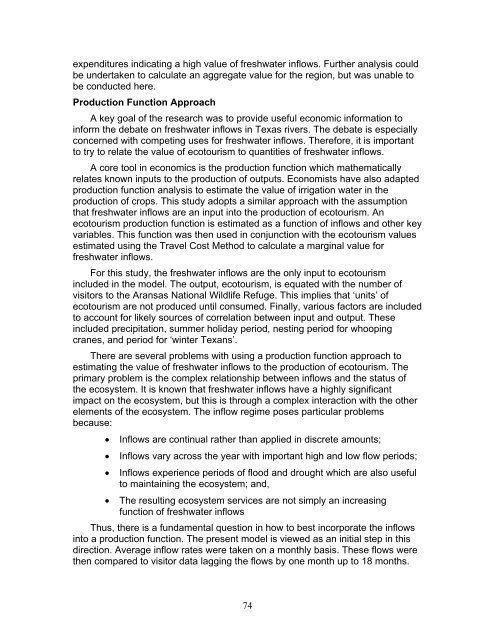The Economic Value of Water and Ecosystem Preservation
The Economic Value of Water and Ecosystem Preservation
The Economic Value of Water and Ecosystem Preservation
Create successful ePaper yourself
Turn your PDF publications into a flip-book with our unique Google optimized e-Paper software.
expenditures indicating a high value <strong>of</strong> freshwater inflows. Further analysis could<br />
be undertaken to calculate an aggregate value for the region, but was unable to<br />
be conducted here.<br />
Production Function Approach<br />
A key goal <strong>of</strong> the research was to provide useful economic information to<br />
inform the debate on freshwater inflows in Texas rivers. <strong>The</strong> debate is especially<br />
concerned with competing uses for freshwater inflows. <strong>The</strong>refore, it is important<br />
to try to relate the value <strong>of</strong> ecotourism to quantities <strong>of</strong> freshwater inflows.<br />
A core tool in economics is the production function which mathematically<br />
relates known inputs to the production <strong>of</strong> outputs. Economists have also adapted<br />
production function analysis to estimate the value <strong>of</strong> irrigation water in the<br />
production <strong>of</strong> crops. This study adopts a similar approach with the assumption<br />
that freshwater inflows are an input into the production <strong>of</strong> ecotourism. An<br />
ecotourism production function is estimated as a function <strong>of</strong> inflows <strong>and</strong> other key<br />
variables. This function was then used in conjunction with the ecotourism values<br />
estimated using the Travel Cost Method to calculate a marginal value for<br />
freshwater inflows.<br />
For this study, the freshwater inflows are the only input to ecotourism<br />
included in the model. <strong>The</strong> output, ecotourism, is equated with the number <strong>of</strong><br />
visitors to the Aransas National Wildlife Refuge. This implies that ‘units’ <strong>of</strong><br />
ecotourism are not produced until consumed. Finally, various factors are included<br />
to account for likely sources <strong>of</strong> correlation between input <strong>and</strong> output. <strong>The</strong>se<br />
included precipitation, summer holiday period, nesting period for whooping<br />
cranes, <strong>and</strong> period for ‘winter Texans’.<br />
<strong>The</strong>re are several problems with using a production function approach to<br />
estimating the value <strong>of</strong> freshwater inflows to the production <strong>of</strong> ecotourism. <strong>The</strong><br />
primary problem is the complex relationship between inflows <strong>and</strong> the status <strong>of</strong><br />
the ecosystem. It is known that freshwater inflows have a highly significant<br />
impact on the ecosystem, but this is through a complex interaction with the other<br />
elements <strong>of</strong> the ecosystem. <strong>The</strong> inflow regime poses particular problems<br />
because:<br />
• Inflows are continual rather than applied in discrete amounts;<br />
• Inflows vary across the year with important high <strong>and</strong> low flow periods;<br />
• Inflows experience periods <strong>of</strong> flood <strong>and</strong> drought which are also useful<br />
to maintaining the ecosystem; <strong>and</strong>,<br />
• <strong>The</strong> resulting ecosystem services are not simply an increasing<br />
function <strong>of</strong> freshwater inflows<br />
Thus, there is a fundamental question in how to best incorporate the inflows<br />
into a production function. <strong>The</strong> present model is viewed as an initial step in this<br />
direction. Average inflow rates were taken on a monthly basis. <strong>The</strong>se flows were<br />
then compared to visitor data lagging the flows by one month up to 18 months.<br />
74
















